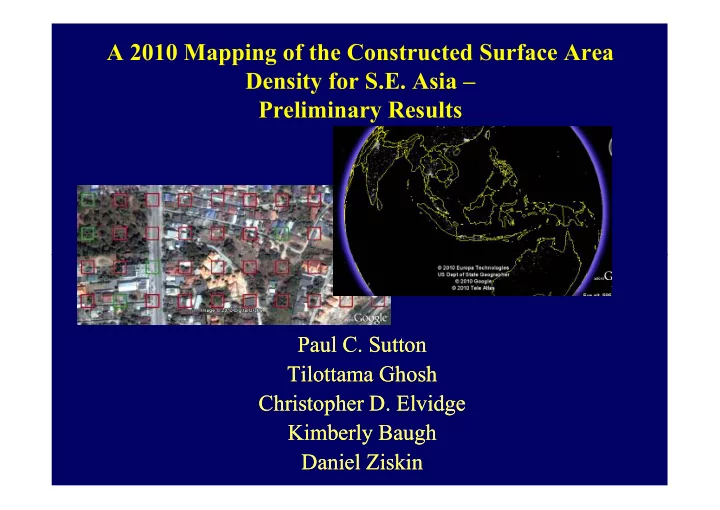

A 2010 Mapping of the Constructed Surface Area Density for S.E. Asia – Preliminary Results Paul C. Sutton Paul C. Sutton Tilottama Ghosh Tilottama Ghosh Christopher D. Elvidge Christopher D. Elvidge Kimberly Baugh Kimberly Baugh Daniel Daniel Ziskin Ziskin
Outline • Motivation for Mapping Constructed Impervious Surfaces • Methods: Data Acquisition – http://www.ngdc.noaa.gov/dmsp/imaps/isamapper/ • Methods: Regression Analysis – %ISA = B1*+ighttime Lights + B2* Population Density – %ISA = B1*+ighttime Lights + B2* Population Density • Results: Data Product . ISA of Southeast Asia at ~ 1km 2 • Discussion and Future Research
�������������������������������� • Constructed Areas (aka ISA) have significant environmental impacts – ISA alters sensible and latent heat fluxes – causing urban heat islands – In naturally vegetated areas anthropogenic ISA reduces carbon sequestration – ISA alters the character of watersheds by increasing frequency and magnitude of surface runoff pulses – ISA can alter the shape of stream channels, raising water temperatures, and sweeping urban pollutants into aquatic environments – – ISA causes reduced surface water quality, increased flooding, and reductions in rates of groundwater ISA causes reduced surface water quality, increased flooding, and reductions in rates of groundwater recharge • Anthropogenic Impervious Surface can be mapped globally at moderate spatial resolutions using satellite imagery – Anthropogenic ISA is typically associated with developed areas. – The relationship between human settlement density and ISA fraction is regionally variable • Anthropogenic Impervious Surface is a significant and universal proxy measure of human impact on the environment ���������������������������������������������������������������������������������������� ����������������!"##$% ����������������� &� ����������������������������������������������������������������������� �����������������'��� ���������((!)%�����*+*, ������������������������������������������������������-��.����������������������/�0���������������1��������������������������2���3�������4������!"##5%� ����������������������������������� ������������������������������ ������� "##5��5�����*$6"+*$5$
Methods: Data Acquisition !������������������������������� !������������������"#�����$����%��& !��������������������������������' �������������������������������(��� $�(������(���������������������� #��������)�*����������������������� �����)�������������������+�����,��� ������������������������������(���� ��������������������- ��������������������- ����&77000����'���������7����7�����7���������7
The Town of Nakhon Ratchasima, Thailand Population ~150,000 High Resolution Satellite Imagery DMSP OLS imagery overlaid as from Google Earth is used to classify A KML file via the Google Earth A sample of pixels from SE asia. Plug.in
Image Classification with the Light Picker In this preliminary study we have done this about 10,000 times to produce about 35 data points to build a regression model Once a point sample has been classified it turns green
One pixel is a bit of work… Our dependent variable: “% Constructed Area” is Determined by the fraction Of the 256 (16 x 16 red square point samples in each DMSP Pixel) That are classified as one of the following ‘Developed’ categories: ‘Street/Road’, ‘Flat Roof’, ‘Other Roof’ or ‘Other Constructed’
Regression Model Development • We use a DMSP OLS nighttime lights dataset and the Landscan Population dataset to predict % Constructed Area as follows: • % Cons. Area = β1* DMSP D+ value + β2 * Landscan • % Cons. Area = β1* DMSP D+ value + β2 * Landscan • This model will produce non.zero Constructed Area percentages in areas with no light and in areas with no population.
Radiance Calibrated image of 2010 (F16) 2�����'��'���.�������1���4���������8�������9�����:�����"#*# �����+9����'������������������1��+;8�������'����'���������0��������������������������������� 30 arc;second grid or approximately 1 km 2 at the equator
2008 LandScan population grid • US Laboratory Department of Energy, Oak Ridge National Laboratory • Representing ambient population count per cell • 30 arc;second grid or approximately 1 km 2 at the equator
Parameter Estimation R 2 = 0.87 α = 0.0 (forced) β1 = .182 β2 = .00063 β2 = .00063
Constructed Area of South East Asia
Estimated Constructed Area of Hanoi and HCMC Ho Chi Minh Hanoi # *#�+ *## #�*�+ " "�+ < <�+ *#
Table of Results Total ISA GDP 2008 - (millions) GDP (millions)/ISA Countries Population Total Area (km 2 ) (km 2 ) %ISA US$ ISA (m 2 )/person (km 2 ) Brunei 318,930 5,804 114 1.97 19,559 359 171 Cambodia 14,282,900 182,857 117 0.06 28,408 8 242 East Timor 1,024,330 15,154 13 0.09 880 13 67 Indonesia 229,554,000 1,896,490 5,516 0.29 907,955 24 165 Laos 6,696,710 230,940 99 0.04 13,181 15 133 Malaysia 24,087,200 330,669 2,797 0.85 384,002 116 137 Myanmar (Burma) 46,965,100 670,705 392 0.06 ? 8 ? Papua New Guinea 5,424,430 466,753 98 0.02 14,337 18 146 Philippines 90,491,600 296,755 1,452 0.49 317,352 16 219 Singapore 4,314,760 552 314 56.89 238,685 73 760 Thailand 64,857,000 515,058 3,511 0.68 544,913 54 155 Vietnam 84,658,300 326,884 2,295 0.70 240,292 27 105 Source of GDP data - World Bank website
Conclusion Preliminary Results Only (+ ~30 pixels) We’d love to have others join us in the classification tasks on the ‘ISA Picker’ ☺ ☺ ☺ ☺ Regionalization of Parameter Estimation improves accuracy of estimation. Relative to prior studies in the U.S. it takes more light and more people to predict the same percentage of pavement in SouthEast Asia. pavement in SouthEast Asia. Richer dataset not being exploited because of our simple classification into constructed vs. not.constructed. Future research will explore the relative frequency of various categories on a regional and/or national basis.
Recommend
More recommend